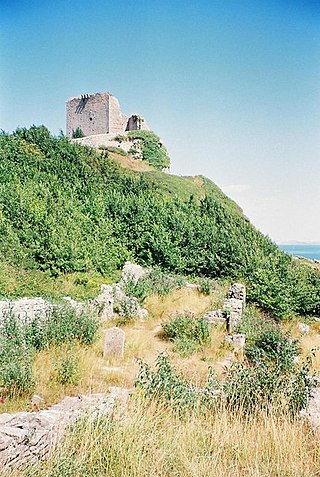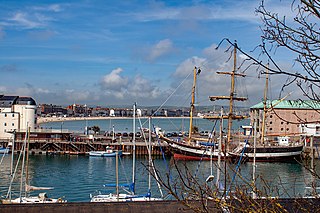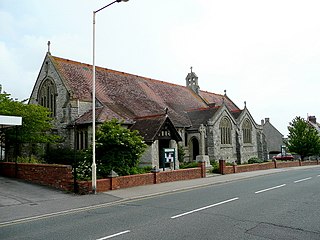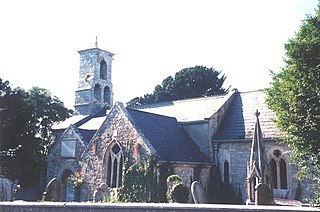
Dorset is a ceremonial county in South West England. It is bordered by Somerset to the north-west, Wiltshire to the north and the north-east, Hampshire to the east, the Isle of Wight across the Solent to the south-east, the English Channel to the south, and Devon to the west. The largest settlement is Bournemouth, and the county town is Dorchester.

The Isle of Portland is a tied island, 6 kilometres (4 mi) long by 2.7 kilometres (1.7 mi) wide, in the English Channel. The southern tip, Portland Bill, lies 8 kilometres (5 mi) south of the resort of Weymouth, forming the southernmost point of the county of Dorset, England. A barrier beach called Chesil Beach joins Portland with mainland England. The A354 road passes down the Portland end of the beach and then over the Fleet Lagoon by bridge to the mainland. The population of Portland is 13,417.

Weymouth and Portland was a local government district with borough status in Dorset, England from 1974 to 2019. It consisted of the resort of Weymouth and the Isle of Portland, and includes the areas of Wyke Regis, Preston, Melcombe Regis, Upwey, Broadwey, Southill, Nottington, Westham, Radipole, Chiswell, Castletown, Fortuneswell, Weston, Southwell and Easton; the latter six being on the Isle of Portland.

Sandsfoot Castle, also known historically as Weymouth Castle, is an artillery fort constructed by Henry VIII near Weymouth, Dorset. It formed part of the King's Device programme to protect against invasion from France and the Holy Roman Empire, and defended the Weymouth Bay anchorage. The stone castle had an octagonal gun platform, linked to a residential blockhouse, and was completed by 1542 at a cost of £3,887. Earthwork defences were built around the landward side of the castle, probably in 1623. Sandsfoot saw service during the English Civil War, when it was held by Parliament and Royalists in turn during the conflict. It survived the interregnum but, following Charles II's restoration to the throne, the fortress was withdrawn from military use in 1665.

Wyke Regis is a village in south Dorset, England. The village is part of the south western suburbs of Weymouth, on the northern shore of Portland Harbour and the south-eastern end of Chesil Beach. Wyke is 15 kilometres (9 mi) south of the county town, Dorchester. The village has a population of around 5,500.

South Dorset is a constituency represented in the House of Commons of the UK Parliament since 2010 by Richard Drax, a Conservative. The constituency was created as a consequence of the Redistribution of Seats Act 1885, although the area covered has changed since then.
Radipole is a suburb of Weymouth in Dorset, England.

Rufus Castle, also known as Bow and Arrow Castle, is a partially ruined castle overlooking Church Ope Cove on Portland, England. Its name derives from King William II, known as William Rufus, for whom the original castle was built.

Weymouth is a sea-side town and civil parish in the Dorset district, in the ceremonial county of Dorset, on the English Channel coast of England. Situated on a sheltered bay at the mouth of the River Wey, 11 km (7 mi) south of the county town of Dorchester, Weymouth had a population of 53,427 in 2021. It is the third-largest settlement in Dorset after Bournemouth and Poole. The greater Weymouth urban area has a population of 72,802.

South West Coaches is a privately owned bus company that operates services around Dorset, Somerset, and Wiltshire, in South West England.

Wyke Castle is a residence at the top of Pirates Lane, in Wyke Regis, near Weymouth, Dorset, England. It was built around 1855 and has been a Grade II listed building since 1974. It now forms three separate dwellings.

Ferry Bridge is at the beginning of the causeway to the Isle of Portland, Dorset, England, and is the point at which the Fleet lagoon joins Portland Harbour. It is situated several hundred metres south of Portland's boundary with the village of Wyke Regis, Weymouth. To the west of Ferry Bridge is the start of The Fleet, which is an internationally important nature reserve that extends to Abbotsbury Swannery, while to the east is Portland Harbour. Along the harbour side is Smallmouth Beach. The only road between Portland and the Mainland passes across Ferry Bridge.

St. John's Church is an Anglican Church of England church in Fortuneswell, on the Isle of Portland, Dorset. It was built between 1838–40 and has been a Listed Grade II building since January 1951. The churchyard walls, gate piers, railings, and steps of St. John's Church, dating from 1839–40, became Grade II Listed in September 1978. At this same time, two headstone monuments, about 5 metres north east from the west tower of the church became Grade II Listed.

Holy Trinity Church is a Church of England church in Weymouth, Dorset, England. Built of Portland stone in 1834–36, and extended and re-oriented in 1886–87, the church is a Grade II* listed building. Designed by Philip Wyatt, it has been described as being of "intrinsic architectural interest", having an "unusual scheme of development" and "occupying a significant position on the axis of Weymouth's Town Bridge".

St Mary's Church is a Church of England parish church in Weymouth, Dorset, England. Built of Portland stone in 1815–1817, the church has been described as having an "austere design in Palladian mode". It has been a Grade I listed building since 1953.

St Paul's Church is a Church of England parish church in Westham, Weymouth, Dorset, England. Designed by George Fellowes Prynne, the bulk of the church was built in 1894–96. It has been a Grade II listed building since 1974, with the World War I memorial outside also designated Grade II in 2016. In their book The Buildings of England: Dorset, John Newman and Nikolaus Pevsner noted the church's "idiosyncratic but convincing design".

St Laurence's Church is a Church of England parish church in Upwey, Dorset, England. Much of the existing church dates to the late 15th century, with some earlier fabric and later additions of the 19th and 20th centuries. It is a Grade II* listed building.

St Ann's Church is a Church of England parish church in Radipole, Weymouth, Dorset, England. The church dates to the 13th century, with later additions, and is a Grade II* listed building. Both the boundary wall of the churchyard and church room opposite are also Grade II listed.

Wyke Regis Methodist Church is a former Methodist church in Wyke Regis, Dorset, England. Designed by Ford & Slater of Burslem, it was built in 1903 and remained in use until 2021.


















